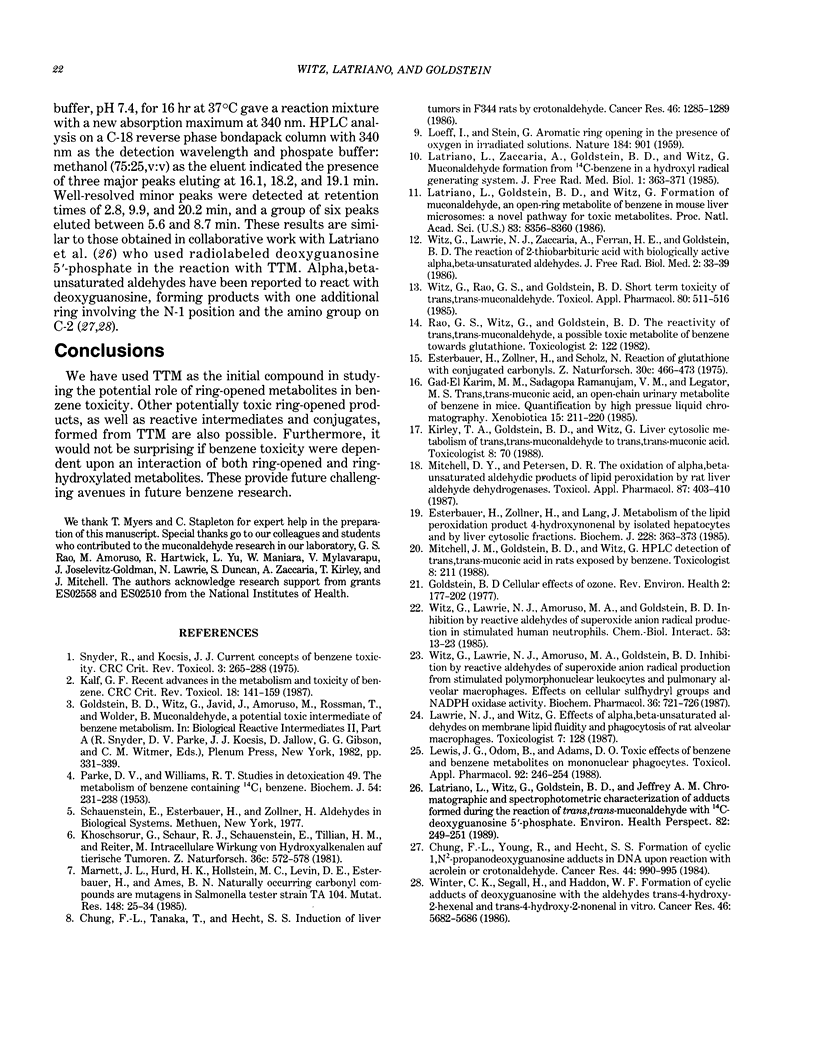Abstract
We have previously hypothesized that ring-opened metabolites may play an important role in benzene toxicity. In this paper we review recent work related to this hypothesis. trans,trans-Muconaldehyde (TTM), a six-carbon diene dialdehyde, was shown by our laboratory to be a microsomal metabolite of benzene. This compound is a ring-opened metabolite of benzene that is hematotoxic in mice. The toxicity of TTM may stem in part from its ability to act as a direct-acting alkylating agent involving interaction with cellular sulfhydryls and/or amino groups. On the other hand, metabolism to the diacid trans,trans-muconic acid (MA), a known urinary metabolite of benzene, may represent detoxification since this results in loss of electrophilicity of the compound. Preliminary results indicate that TTM can be metabolized to MA in vitro and in vivo. The interaction of TTM in vitro with macrophages and neutrophils, key cells in the bone marrow, results in cell membrane changes, including loss of activity in the plasma membrane-bound NADPH-dependent oxidase and decreases in membrane lipid fluidity. Deoxyguanosine also was found to react with TTM, forming several different products. These findings may be due to TTM acting directly as an alkylating agent.
Full text
PDF



Selected References
These references are in PubMed. This may not be the complete list of references from this article.
- Chung F. L., Tanaka T., Hecht S. S. Induction of liver tumors in F344 rats by crotonaldehyde. Cancer Res. 1986 Mar;46(3):1285–1289. [PubMed] [Google Scholar]
- Chung F. L., Young R., Hecht S. S. Formation of cyclic 1,N2-propanodeoxyguanosine adducts in DNA upon reaction with acrolein or crotonaldehyde. Cancer Res. 1984 Mar;44(3):990–995. [PubMed] [Google Scholar]
- Esterbauer H., Zollner H., Lang J. Metabolism of the lipid peroxidation product 4-hydroxynonenal by isolated hepatocytes and by liver cytosolic fractions. Biochem J. 1985 Jun 1;228(2):363–373. doi: 10.1042/bj2280363. [DOI] [PMC free article] [PubMed] [Google Scholar]
- Gad-El Karim M. M., Ramanujam V. M., Legator M. S. trans,trans-Muconic acid, an open-chain urinary metabolite of benzene in mice. Quantification by high-pressure liquid chromatography. Xenobiotica. 1985 Mar;15(3):211–220. doi: 10.3109/00498258509045351. [DOI] [PubMed] [Google Scholar]
- Goldstein B. D. Cellular effects of ozone. Rev Environ Health. 1977;2(3):177–202. [PubMed] [Google Scholar]
- Kalf G. F. Recent advances in the metabolism and toxicity of benzene. Crit Rev Toxicol. 1987;18(2):141–159. doi: 10.3109/10408448709089859. [DOI] [PubMed] [Google Scholar]
- Latriano L., Goldstein B. D., Witz G. Formation of muconaldehyde, an open-ring metabolite of benzene, in mouse liver microsomes: an additional pathway for toxic metabolites. Proc Natl Acad Sci U S A. 1986 Nov;83(21):8356–8360. doi: 10.1073/pnas.83.21.8356. [DOI] [PMC free article] [PubMed] [Google Scholar]
- Latriano L., Witz G., Goldstein B. D., Jeffrey A. M. Chromatographic and spectrophotometric characterization of adducts formed during the reaction of trans,trans-muconaldehyde with 14C-deoxyguanosine 5'-phosphate. Environ Health Perspect. 1989 Jul;82:249–251. doi: 10.1289/ehp.8982249. [DOI] [PMC free article] [PubMed] [Google Scholar]
- Latriano L., Zaccaria A., Goldstein B. D., Witz G. Muconaldehyde formation from 14C-benzene in a hydroxyl radical generating system. J Free Radic Biol Med. 1985;1(5-6):363–371. doi: 10.1016/0748-5514(85)90148-5. [DOI] [PubMed] [Google Scholar]
- Lewis J. G., Odom B., Adams D. O. Toxic effects of benzene and benzene metabolites on mononuclear phagocytes. Toxicol Appl Pharmacol. 1988 Feb;92(2):246–254. doi: 10.1016/0041-008x(88)90384-5. [DOI] [PubMed] [Google Scholar]
- Marnett L. J., Hurd H. K., Hollstein M. C., Levin D. E., Esterbauer H., Ames B. N. Naturally occurring carbonyl compounds are mutagens in Salmonella tester strain TA104. Mutat Res. 1985 Jan-Feb;148(1-2):25–34. doi: 10.1016/0027-5107(85)90204-0. [DOI] [PubMed] [Google Scholar]
- Mitchell D. Y., Petersen D. R. The oxidation of alpha-beta unsaturated aldehydic products of lipid peroxidation by rat liver aldehyde dehydrogenases. Toxicol Appl Pharmacol. 1987 Mar 15;87(3):403–410. doi: 10.1016/0041-008x(87)90245-6. [DOI] [PubMed] [Google Scholar]
- PARKE D. V., WILLIAMS R. T. Studies in detoxication. XLIX. The metabolism of benzene containing (14C1) benzene. Biochem J. 1953 May;54(2):231–238. doi: 10.1042/bj0540231. [DOI] [PMC free article] [PubMed] [Google Scholar]
- Snyder R., Kocsis J. J. Current concepts of chronic benzene toxicity. CRC Crit Rev Toxicol. 1975 Jun;3(3):265–288. doi: 10.3109/10408447509079860. [DOI] [PubMed] [Google Scholar]
- Winter C. K., Segall H. J., Haddon W. F. Formation of cyclic adducts of deoxyguanosine with the aldehydes trans-4-hydroxy-2-hexenal and trans-4-hydroxy-2-nonenal in vitro. Cancer Res. 1986 Nov;46(11):5682–5686. [PubMed] [Google Scholar]
- Witz G., Lawrie N. J., Amoruso M. A., Goldstein B. D. Inhibition by reactive aldehydes of superoxide anion radical production from stimulated polymorphonuclear leukocytes and pulmonary alveolar macrophages. Effects on cellular sulfhydryl groups and NADPH oxidase activity. Biochem Pharmacol. 1987 Mar 1;36(5):721–726. doi: 10.1016/0006-2952(87)90725-8. [DOI] [PubMed] [Google Scholar]
- Witz G., Lawrie N. J., Amoruso M. A., Goldstein B. D. Inhibition by reactive aldehydes of superoxide anion radical production in stimulated human neutrophils. Chem Biol Interact. 1985 Feb-Apr;53(1-2):13–23. doi: 10.1016/s0009-2797(85)80080-6. [DOI] [PubMed] [Google Scholar]
- Witz G., Lawrie N. J., Zaccaria A., Ferran H. E., Jr, Goldstein B. D. The reaction of 2-thiobarbituric acid with biologically active alpha,beta-unsaturated aldehydes. J Free Radic Biol Med. 1986;2(1):33–39. doi: 10.1016/0748-5514(86)90121-2. [DOI] [PubMed] [Google Scholar]
- Witz G., Rao G. S., Goldstein B. D. Short-term toxicity of trans,trans-muconaldehyde. Toxicol Appl Pharmacol. 1985 Sep 30;80(3):511–516. doi: 10.1016/0041-008x(85)90396-5. [DOI] [PubMed] [Google Scholar]


